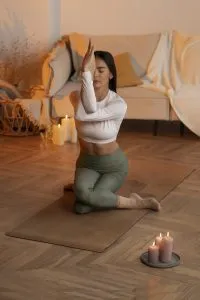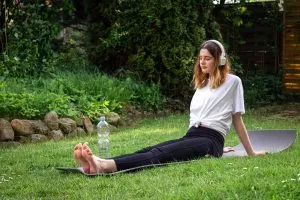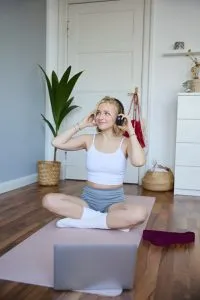Imagine you’re flowing through your favorite vinyasa sequence, feeling zen and connected to your breath. Suddenly, your hands start sliding forward in downward dog, and your feet slip out from under you in warrior III. Sound familiar?
If you’ve ever found yourself doing an unintentional “slip and slide” on your yoga mat instead of the graceful flow you intended, you’re not alone. The culprit? Your yoga mat texture might not be playing nice with your hands and feet.
Here’s the thing most yogis don’t realize until they’ve face-planted a few times: yoga mat texture isn’t just about aesthetics or price point. It’s the unsung hero (or villain) of your entire practice, determining whether you’ll nail that challenging pose or end up in a frustrated heap on the floor.
In this guide, we’ll dive deep into why texture matters so much for grip for hands and feet, how to find the best yoga mat for stability, and which non-slip yoga mat options will actually keep you grounded—literally and figuratively.
What Exactly Is Yoga Mat Texture (And Why Should You Care)?
Let’s start with the basics. Yoga mat texture refers to the surface pattern, feel, and grip characteristics of your mat. Think of it as your mat’s personality—some are smooth operators, others are grippy go-getters, and some fall somewhere in between.
But here’s where it gets interesting: that texture isn’t just there to look pretty. It’s working overtime to create friction between your skin and the mat surface, giving you the stability you need to hold poses without sliding around like a newborn giraffe on ice.
The Science Behind Grip
When we talk about grip for hands and feet, we’re really talking about friction. The more textured surface area that comes into contact with your palms and soles, the more friction you create. More friction equals better stability, which equals fewer embarrassing slips during your practice.
It’s like the difference between walking on smooth ice versus walking on a sidewalk with traction strips. Same concept, different application.
How Yoga Mat Texture Affects Your Hands During Practice
Your hands are your foundation in so many poses—downward dog, plank, crow pose, handstands (if you’re feeling adventurous). When your yoga mat texture doesn’t provide adequate grip, several things happen:
The Sliding Struggle
Ever notice how your hands start creeping forward during a longer downward dog hold? That’s not your imagination—it’s physics. Without proper texture to create friction, the pressure from your body weight combined with any moisture (hello, sweaty palms!) creates a slippery situation.
This isn’t just annoying; it can actually mess with your alignment. When your hands slide, you compensate by putting extra pressure on your wrists, which can lead to discomfort or injury over time.
The Grip Compensation Game
When yogis can’t trust their mat’s grip, they often overcompensate by gripping too hard with their fingers. This creates unnecessary tension in the hands, wrists, and forearms—the opposite of what we want in yoga practice.
A non-slip yoga mat with the right texture lets you maintain a soft, stable connection without white-knuckling your way through class.
Why Your Feet Need the Right Yoga Mat Texture Too
Your feet might not get as much attention as your hands in yoga discussions, but they’re equally important for stability and balance. Here’s how yoga mat texture impacts your foundation from the ground up:
Standing Pose Stability
In standing poses like warrior II, triangle, or tree pose, your feet are literally your anchor. The best yoga mat for stability provides enough texture to prevent micro-slips that can throw off your balance without you even realizing it.
I learned this lesson the hard way during a particularly sweaty power yoga class. My smooth mat seemed fine until we hit a series of balance poses, and suddenly I felt like I was practicing on a banana peel. Not exactly the zen experience I was going for!
The Sweat Factor
Let’s be real—yoga makes you sweat. And when moisture meets smooth surfaces, things get slippery fast. Textured mats are better at wicking away moisture and maintaining grip even when your practice heats up.
This is especially crucial for hot yoga practitioners, where sweat is basically part of the experience. A non-slip yoga mat with good texture can be the difference between a challenging practice and a dangerous one.
The Great Texture Debate – Smooth vs. Textured vs. Hybrid
Not all yoga mat textures are created equal. Let’s break down the main categories and what they mean for your hands and feet:
Smooth Mats – The Gliders
Pros:
- Easy to clean (fewer nooks and crannies for bacteria)
- Comfortable for seated and lying poses
- Great for dynamic flows that require sliding movements
Cons:
- Can be slippery, especially when wet
- Less tactile feedback for alignment
- May not provide enough grip for challenging poses
Best for: Beginners, gentle yoga styles, people who prioritize easy maintenance
Textured Mats – The Grippers
Pros:
- Superior grip for hands and feet
- Better sweat absorption
- Enhanced tactile awareness for alignment
- Often made from eco-friendly materials
Cons:
- Can be harder to clean thoroughly
- May feel uncomfortable for some sensitive practitioners
- Can be “too grippy” for flow-style movements
Best for: Hot yoga, challenging poses, practitioners who tend to slip on smooth mats
Hybrid Mats – The Best of Both Worlds
Some manufacturers have created mats with smooth tops and textured bottoms (or vice versa), letting you flip based on your practice needs. It’s like having two mats in one!
Choosing the Right Yoga Mat Texture for Your Practice Style
Your ideal yoga mat texture depends heavily on what type of yoga you practice. Here’s a breakdown:
Dynamic Styles (Vinyasa, Ashtanga, Power Yoga)
For flow-based practices, you want enough grip to prevent slipping but not so much texture that it impedes smooth transitions. A non-slip yoga mat with moderate texture often works best.
Static Styles (Hatha, Iyengar, Restorative)
When you’re holding poses for longer periods, maximum grip becomes more important than easy gliding. A more textured surface provides the best yoga mat for stability in these practices.
Hot Yoga (Bikram, Heated Vinyasa)
Sweat changes everything. You need a mat that maintains grip even when wet, which typically means choosing a textured surface with good moisture-wicking properties.
Material Matters – How Different Materials Affect Texture
The material your mat is made from greatly influences its texture and grip properties:
PVC (Polyvinyl Chloride)
- Typically smooth with subtle texture
- Excellent durability and stickiness when clean
- Not eco-friendly but very reliable for grip
Natural Rubber
- Naturally textured surface
- Excellent grip even when wet
- Eco-friendly but may have latex concerns
TPE (Thermoplastic Elastomer)
- Can be smooth or textured
- Good eco-friendly alternative to PVC
- Moderate grip properties
Cork and Jute
- Naturally textured and grippy
- Becomes more grippy when slightly moist
- Sustainable and biodegradable options
Red Flags – Signs Your Yoga Mat Texture Isn’t Working
How do you know if your current mat’s texture isn’t cutting it? Watch for these warning signs:
- Sliding hands in downward dog or plank pose
- Slipping feet during standing balance poses
- Overgripping with fingers or toes to compensate
- Wrist pain from compensating for poor grip
- Loss of confidence in challenging poses due to instability
If any of these sound familiar, it might be time to reassess your yoga mat texture choice.
Maintenance Tips to Preserve Your Mat’s Texture and Grip
Even the best yoga mat for stability won’t help if you don’t maintain it properly. Here’s how to keep your mat’s texture working for you:
Regular Cleaning
- Wipe down after each practice
- Deep clean weekly with appropriate cleaners
- Avoid harsh chemicals that can break down texture
Proper Storage
- Roll (don’t fold) to prevent creasing
- Store in a cool, dry place
- Avoid direct sunlight which can degrade materials
Know When to Replace
- Visible wear patterns or smooth spots
- Persistent slipping despite cleaning
- Unpleasant odors that won’t go away
The Bottom Line – Texture Is Personal
Here’s the truth: there’s no one-size-fits-all answer to yoga mat texture. What feels like the perfect non-slip yoga mat to your yoga buddy might feel like sandpaper to you, and that’s totally normal.
The best approach? Try before you buy when possible. Many yoga studios let you test different mats, and some retailers offer return policies if the texture doesn’t work for your practice.
Frequently Asked Questions
How do I know if I need more or less texture on my yoga mat?
Pay attention to your practice. If you’re sliding around, especially in poses like downward dog or during balance work, you likely need more texture. If you find the mat uncomfortably rough or it’s interfering with smooth transitions, you might prefer less texture. The best yoga mat for stability is one that keeps you grounded without discomfort.
Will a textured yoga mat help with sweaty hands and feet?
Yes! Textured surfaces typically provide better grip for hands and feet even when moisture is present. The texture creates more contact points and often helps wick moisture away from the surface. Look for materials like natural rubber or cork that actually become grippier when slightly damp.
Can yoga mat texture cause skin irritation?
Some people with sensitive skin may find very textured mats uncomfortable, especially during longer practices or poses that involve sliding. If you experience irritation, try a non-slip yoga mat with subtler texture, or consider using a yoga towel on top of your mat for extra comfort.
How often should I replace my yoga mat if the texture wears down?
Most quality yoga mats should maintain their texture for 1-2 years with regular use (3-4 times per week). Signs it’s time to replace include smooth spots where the texture has worn away, persistent slipping despite proper cleaning, or visible cracking in the surface.
Are expensive yoga mats always better for texture and grip?
Not necessarily! While higher-priced mats often use better materials and construction, the best yoga mat for stability is the one that matches your specific needs and practice style. Some mid-range mats provide excellent texture and grip. Focus on finding the right material and texture level rather than just the highest price tag.
Ready to Find Your Perfect Match?
Choosing the right yoga mat texture is like finding the perfect pair of shoes—it’s deeply personal and makes all the difference in your comfort and performance.
Take some time to honestly assess your current practice challenges. Are you slipping? Overgripping? Feeling unstable in poses you used to nail? Your mat’s texture might be the missing piece of your yoga puzzle.
Consider visiting a local yoga studio or retailer where you can actually feel different textures. Many online retailers also offer detailed texture descriptions and return policies, so don’t be afraid to invest in your practice.
Remember, your yoga mat is your portable sanctuary, your foundation for growth, and your partner in this beautiful practice. It deserves as much thoughtful consideration as any other important relationship in your life.
What texture will help you find your most stable, confident, and joyful practice? There’s only one way to find out—get out there and feel the difference for yourself!
Your hands and feet (and your yoga practice) will thank you.














